Keeping competition horses in peak condition through the winter can be a challenge. We delve into the diet plan of Team GB dressage horse Supernova II, to find out the details of his winter feeding regime
Horse: Supernova II (Neville)
The rider: Spencer Wilton
Key stats: 14-year-old, 17.1hh bay Hanoverian gelding (Donnerhall x Weltmeyer) owned by Jen Goodman.
Career résumé: this year alone he won the grand prix special and was third in the grand prix at Darmstadt-Kranichstein CDI4*, 13th in the grand prix freestyle, sixth in the grand prix special and team fourth at the European Championships in Gothenburg, won the grand prix and grand prix special at Hartpury CDI3*, won the grand prix, grand prix special and Nations Cup at Compiègne CDIO5*.
Winter routine: “Neville is the master of quirkiness,” says his groom Claire Hinton.
“He doesn’t have any complete blocks of time off because he gets bored and he doesn’t get turned out because of his previous injuries.
“His routine consists of being fed at 7am, having his hay and then being hand-walked for 20 minutes. Spencer will ride him mid-morning and then he’ll have a lunch feed before being groomed and hand-walked again for 40 minutes at 4pm. He’ll have his dinner about 5pm and then a late-night feed and more hay at 9.30pm.”
Feeding plan: “He has the four feeds because he can be quite fussy and, if I give him two big feeds, he’ll only eat half of it. When he is in lighter work, I do cut the amount of feed down, but he still has four feeds.
“He’s fed Saracen Super Fibre Mix all the time, and Saracen Re-leve Mix and Saracen Competition-Fit Balancer when he’s in work. It is a high-energy diet without cereals, so he has his energy from the fibre and oil, which is great for him because he can be quite hot-headed and excitable. He also has sugar beet, NAF Superflex Senior and the NAF Soya Oil. When he’s competing, he also has NAF Liquid Electro Lytes.
“He has ad-lib haylage, which is a second-cut ryegrass haylage that isn’t too potent, fed from a net during the day to stop him walking it around his stable, and from the floor at night.”
Continued below…

Find out what a Burghley winner gets fed during the winter
We delve into the diet plan of 2017
The quirks: “The first day at a competition, he’ll pick through his morning and lunch feeds and not eat all of it, so I make sure he has the balancer and all his supplements in his night feed, which he always finishes — that way I know he is getting everything he needs.
“He is fed in a manger in his stable because he likes to pick up the bucket, tip the food on the floor and then doesn’t want to eat it.
“He can also be naughty about banging on his door if I’m a bit late feeding him.”
The full version of this article was first published in the 12 October issue of Horse & Hound magazine
For all the latest news analysis, competition reports, interviews, features and much more, don’t miss Horse & Hound magazine, on sale every Thursday.




